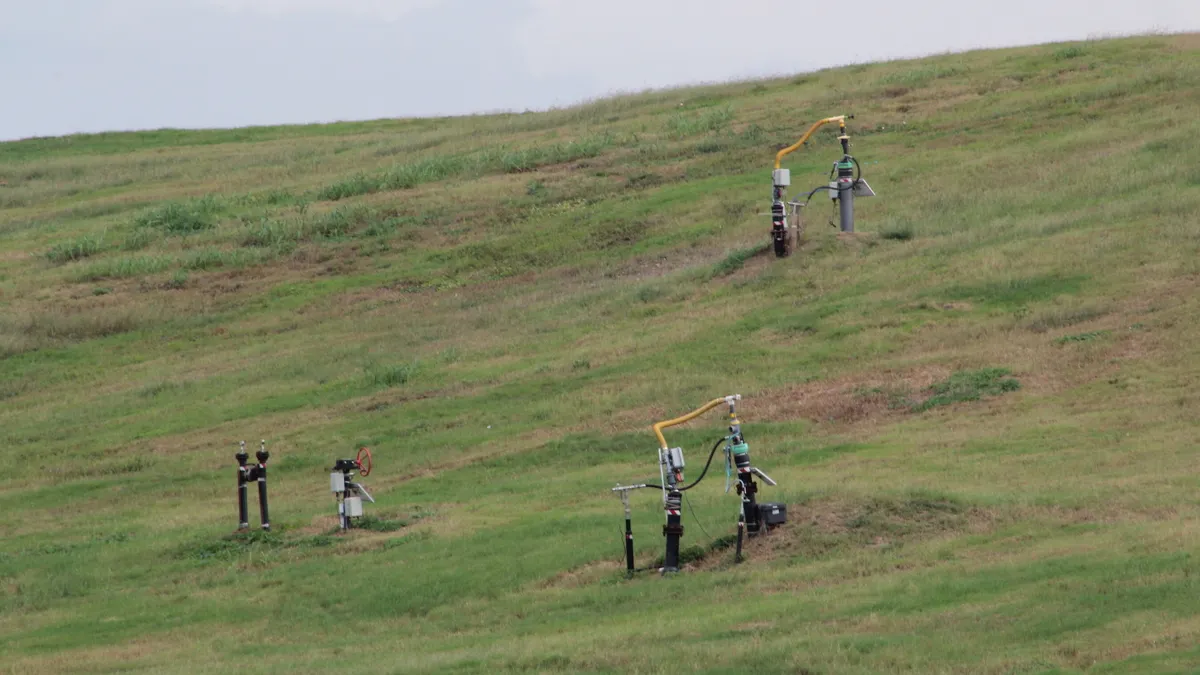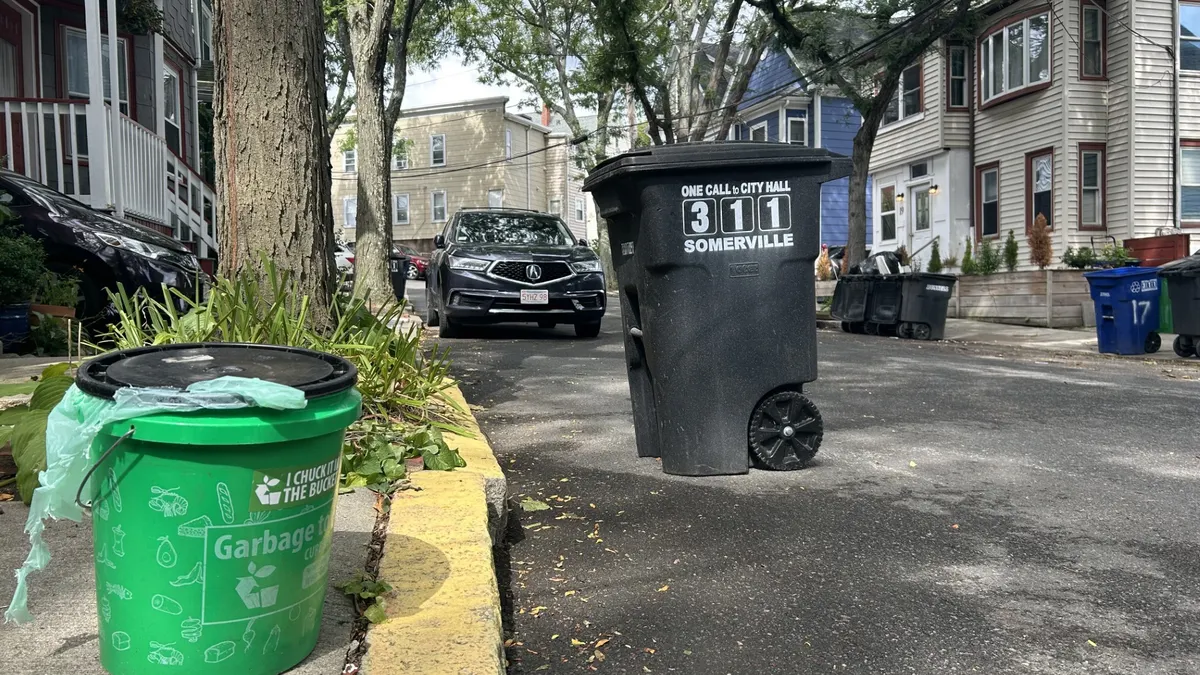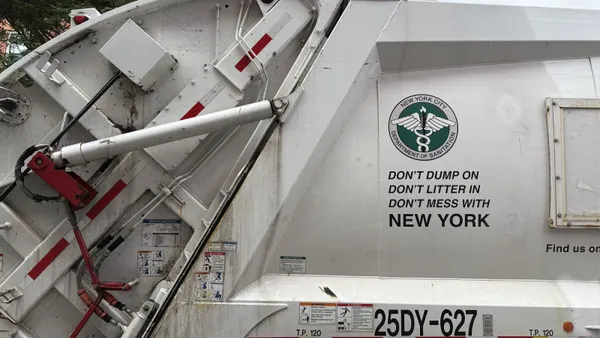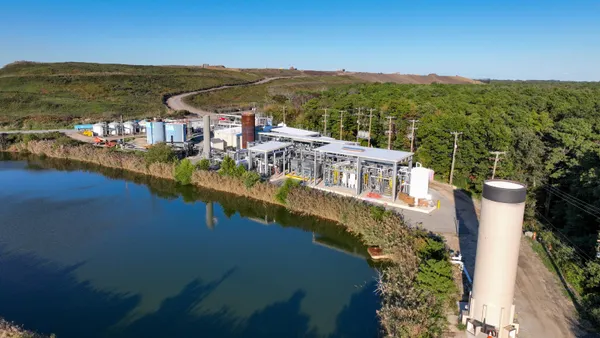Dive Brief:
- Operators of MSW landfills can cut the facilities’ total U.S. methane emissions by nearly half versus a 2023 baseline for $1.3 billion, a report from nonprofit Energy Vision found. The group estimates that the revenue generated from the gas could near $1.9 billion annually, ensuring a return on investment.
- The landfill gas improvements would come primarily from three tactics: adding gas collection and control systems to high-emitting landfills that currently lack such a system; adding gas collection much earlier to landfill working faces; and installing real-time monitoring and automated tuning systems for existing gas collection systems.
- Even if all methane-generating food waste was diverted from landfills, those improvements would still cut total U.S. methane emissions by 4.1% versus a 2023 baseline. Other opportunities exist for reduction in related facilities, including industrial landfills, the report noted.
Dive Insight:
Engineers and policy workers alike have been reconsidering the role of regulation in shaping landfill gas collection in recent years. Last year, the U.S. EPA released a series of white papers exploring a variety of changes to air regulations for MSW landfills, prompting feedback from industry stakeholders. The agency appears to be backing away from some of the ideas floated in that research however, proposing instead a rollback of climate-related regulations.
Meanwhile, states like Colorado and California are actively revising their landfill emissions regulations, tightening restrictions in light of new research finding the climate benefits of tracking and preventing methane emissions from landfills.
States and environmental groups have placed rising pressure on landfill operators to clean up airborne emissions. While the federal government has pulled back on new restrictions, operators have pressed ahead with changes to take advantage of a potential biogas revenue stream.
As a greenhouse gas, methane is more than 80 times stronger than carbon dioxide in the atmosphere over a 20-year timeframe. Energy Vision’s report notes that its proposed actions would cut total U.S. methane emissions by 7.2% compared to 2023 levels.
“[I]mproving landfill gas collection is one of the most cost-effective opportunities to slow near-term warming, while boosting domestic energy production, improving air quality, and protecting public health,” Tom Frankiewicz, a principal at environmental advocacy group RMI, said in an introduction to Energy Vision’s report.
Energy Vision, a nonprofit, supports policies associated with the beneficial use of waste streams. Its board members include Johannes Escudero, CEO and executive director of the RNG Coalition industry group, and Suzanne Hunt, director of policy at anaerobic digestion company Generate Upcycle, among others.
The report acknowledged efforts to remove food waste from landfills entirely. Currently, food waste accounts for about 20% of tonnage nationwide but 58% of fugitive methane emissions, based on federal data. But the report notes that even if that waste were diverted from landfills entirely, there would still be a benefit from improving landfill gas collection.
“Installing advanced landfill technology and diverting food waste from landfills are not rival approaches and both should be pursued,” the report noted.
Currently, the production of energy from landfill gas remains a major driver of landfill gas collection and control system adoption in the United States. That energy can be lucrative for operators if they choose to spend the money to install such systems, or if they install systems required by regulation.
Landfills must surpass several thresholds before they’re required to install gas collection and control systems under federal regulations. For open landfills, those include a permitted design capacity of at least 2.5 million cubic meters of municipal solid waste and an estimated emission rate of at least 34 megagrams per year of non-methane organic compounds. Regulations do not require systems based on methane emissions, a point of contention for environmental groups.
Typically, landfill gas collection systems are installed within a few years of waste being put into place. But installing collection systems within a year of when waste is first placed on a landfill’s working face would save an added 21 million metric tons of carbon dioxide equivalent annually.
Installing real-time well monitoring systems, meanwhile, would save 22.3 million metric tons of carbon dioxide equivalent annually. Energy Vision recommends such systems be installed as part of earlier installation plans.
The group also estimates that about a quarter of MSW landfills that are currently tracking and reporting their emissions to the EPA’s Greenhouse Gas Reporting Program are not collecting their gas at all at the moment.
But installing systems at high-emitting, high-flow landfills that currently aren’t collecting their gas could save roughly 6.2 million metric tons of carbon dioxide equivalent annually. If systems were installed at all high-emitting landfills regardless of gas flow rate, roughly 16 million metric tons of carbon dioxide equivalent could be saved annually. That would represent a 15.9% reduction in MSW landfill methane emissions compared to 2023 levels.
The report emphasizes that the technology it advocates for is currently available. While Energy Vision acknowledged that the Trump administration has been loosening regulations rather than tightening them, states could still take the lead in implementing changes.














